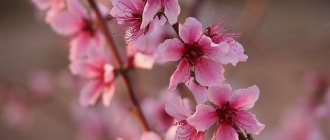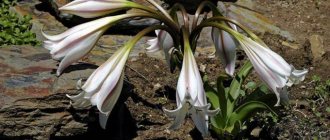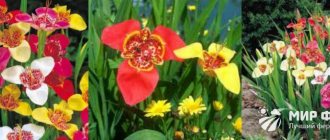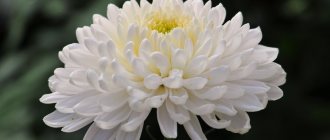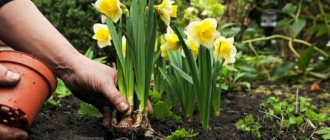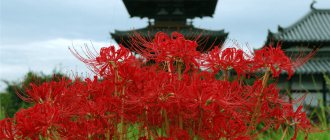General description of bulbous irises
Depending on the type of root system, there are two groups of irises:
- Bulbous.
- Rhizomatous.
In both cases, the plant does not have roots as such: both the bulb and the rhizomes are thickened shoots.
Bulbous irises are low-growing perennial primrose plants. They begin to bloom profusely from the end of April until the last days of June (in the southern regions - even from the end of March). Moreover, the shape of the flowers partly resembles an orchid. They can be one-tone or two-tone in color. Various shades:
- white;
- cream;
- violet;
- blue;
- blue;
- yellow.
The difference between bulbous and rhizomatous irises is associated with the structural features of the roots
What do iris bulbs look like?
The iris bulb is a shortened shoot, shaped like a kidney. If you make a vertical cut, you can see the flower arrow in its embryonic state. Around it, in layers (like onions), there are leaf buds. They accumulate nutrients and ensure plant development and rapid growth of green mass.
Axillary and central buds can be seen between the embryos. The last layer is scales, which act as a cover. The width is not very large - 20-35 mm.
Iris planting material resembles onion sets
Application in landscape design
In order for bulbous irises to fit into the garden, you need to pay attention to several important points:
- A color combination, for example, yellow and blue, always looks attractive.
- Tiering - irises are medium in size, so they can be combined with both taller and shorter plants.
- Flowering period - almost all onion irises are primroses, so it is appropriate to combine them with snowdrops, crocuses, hyacinths, eranthis, daffodils, tulips and others.
As for the planting location, you can decorate any corner of the garden with irises - in ridges, flower beds, mixborders and other compositions.
A simple but very harmonious combination of yellow and blue
Irises in bright colors also look good in single plantings
Different varieties of irises go well together
Multi-tiered flower arrangements along the path
Description and varieties
Let's take the Dutch iris (Iris Hollandica) as a basis.
First, let's move away from the topic and mention that heat-loving irises have three main varieties:
- Juno. They are characterized as heat-loving plants. They are mainly grown as annuals.
- Iridodictiums (they are also called reticulate, for example, Dutch iris Ash Jam). The most unpretentious and undemanding. Their flowering occurs immediately after the snow melts.
- Xyphiums. This variety, in turn, has its own categories: Spanish, American and Dutch. This variety is the most common in our area, so they are the subject of discussion. Hobbyists grow them as annual flowers or indoor flowers. You can determine which species you belong to by the presence of thick scales on the bulbs, which after flowering should be dug up, dried and sent to a cold place to overwinter.
Dutch iris is a xyphium, and it belongs to the hybrid varieties of the Dutch category, bred in the country of the same name. In flower shops they are sold in the form of bulbs covered with multiple layers of scales. In adult form, the height of the plant is on average 0.6 m, but it all depends on the variety. For example, in the Dutch Blue Diamond, Casablanca, Blue Magic and others iris, the height varies between 0.45-0.7 m.
If you plant irises in places inaccessible to the wind, they will not need supports.
The plant itself is winter-hardy. However, in severe frosts they need to be covered with something to prevent freezing. Irises are widely used. They not only decorate garden beds and flower beds, but are also grown for cutting to create bouquets and flower arrangements.
The flowering of the Dutch iris (photos below) occurs in the last week of May and continues until the beginning of June. As for the spectrum of shades of buds, they can be very diverse, from white and blue to orange and purple. After flowering, the plant begins to dry out the foliage, and by the end of August it dries completely.
Methods for propagating bulbous irises
These plants reproduce by bulbs. After 2-3 years they produce large nests containing both large and small bulbs. The bush needs to be dug up in early or mid-summer and sorted:
- large ones must be dried in the sun and stored until autumn in a dark, cool room, then planted;
- small ones should be planted immediately in a new place: they will quickly take root, but the first flowers will appear only after 2-3 years.
Iris can be grown from both bulbs and seeds. They are planted as seedlings as early as February, and the seedlings grow well under normal indoor conditions.
Siberian
It is rare to find Siberian iris in the garden; it is more often found in natural meadows. The Siberian species prefers sunny positions. It forms large bales and is not particularly picky about the soil. Siberian iris can grow up to 70 cm in height. The leaves stand out in appearance; they are quite long, thin, and acquire a slightly blue tint.
The plant produces small white or purple flowers, developing in groups of 2-3 at the end of a long, thin shoot. These are not the only colors, there are also blue irises. Flowering period: May – July.
The Siberian species is frost-resistant, so it grows well in our climate. However, this requires fertile soil with a slightly acidic reaction. Its cultivation is not difficult, there are no big requirements. Since the Siberian species loves moisture, regular watering is most important, especially during drought. Fertilizer is carried out only before planting if the soil in the garden is not fertile enough. The plant can overwinter in the ground without freezing. Despite this, it is worth covering it with leaves or straw.
The most popular varieties of violet-blue flowers. However, in addition to this, other colors are also available. The White Siberian Iris is distinguished by its beautiful white flowers. White Siberian irises are believed to be a variety originating from Germany, although this is not official. Grows well in sunny places, on fertile soil. The variety is considered the most noble.
| Name of iris | Photo |
| Snow Queen | |
| Barbata Media is a plant 40 cm high. | |
| Barbata Elatior - flowers 70 cm high. | |
| Siberian varieties are blue-blue in color - flowers bloom from July to August. Flower petals are smaller, but with more inflorescences. One of the most interesting varieties is Perrys Blue. This variety blooms very profusely with blue spring flowers (blooming: May-June). The plant is completely frost-resistant. It can be planted in flower beds. Looks great next to a pond. |
Cultivars are usually intensely colored, may have white or yellow patterns, and larger inflorescences.
Some varieties of the Siberian species - photos and descriptions
| Variety name | Siberian Iris – photo |
| Concord Crush - flower petals turn blue, turning into a purple hue. The variety is called multi-petalled. Flowering begins in May. | |
| Dear Delight is a flower with blue petals with white spots and a visible vein structure. | |
| Hubbard - varieties characterized by an intense purple-pink color. The flowers are very large, with white coatings along the edges of the petals. | |
| Jamaican Velvet is a variety of intense purple color. The petals are distinguished by lighter spots, which are characteristic of this flower. | |
| Pink Parfait “Pink Parfait” is a multi-petaled variety, the flowers of which reach a diameter of 16 cm. The color of the flowers is pink. | |
| Miss Aplle is a hardy flowering plant that is distinguished by its relatively young age compared to other varieties. The color of the pink petals turns into lavender and purple. | |
| Rosy Bows is a variety with double petals. The pink color turns into light purple, blue. | |
| Jeweled Crown | |
| Fortel | |
| Contrast in Styles |
Rules for planting bulbous irises
Even a novice gardener can grow iris from a bulb. At the same time, it is important not only to choose the right place and prepare the soil, but also to determine the timing.
When to plant bulbous irises in open ground
The period depends on the climatic characteristics of the region. In any case, it is optimal to plant bulbous irises in late summer or autumn:
- In the Moscow region and other regions of the central zone they are planted at the end of August or at the beginning of September.
- In the south, irises can be planted in the second half of October.
- In Siberia and the Urals, the optimal time is the second half of August.
In some cases (for example, planting material was purchased in advance), planting irises with bulbs in the spring is allowed. But in this case, you first need to keep them in the refrigerator for several weeks before transferring them to open ground (late April - early May).
Important! If sprouts emerge at this time, you need to turn the bulb so that the green part faces up. In this case, the seed should be kept in the refrigerator.
To prevent the bulbs from starting to grow ahead of time, they are kept on an insulated balcony
Site selection and soil preparation
Irises love light very much, so the place should be open, without shade. It is good if it is located on a small hill and in shelter from drafts, for example, not far from a house, a fence, powerful bushes and trees (they should not cast a large shadow). Flowers prefer light, fairly fertile soil with a neutral reaction. If the soil is depleted, fertilizers must be added to the planting hole.
How to plant bulbous irises
First, the bulbs need to be kept for several hours in a special pickling agent or in a weak 1% solution of potassium permanganate. The landing algorithm is as follows:
- Clear and dig up the area.
- Form planting holes of shallow depth up to 8 cm (3 times greater than the height of the bulb) at a distance of 10 cm from each other (3 times greater than the diameter of the bulb).
- Lay a small layer of drainage - small stones, pebbles, expanded clay.
- Cover with pre-prepared fertile soil (you can add superphosphates and potassium salt).
- Root the seedlings
- Water generously.
Important! To help the soil retain moisture longer, it is recommended to lay a small layer of peat or compost mulch.
Plant characteristics
Irises: planting and care in open ground
Based on the impressive species diversity, as well as thanks to the constant work of breeders, the appearance of irises can be very different, as well as their botanical features. However, some characteristics of plants that are characteristic of them are common to all species.
Thus, the stems have a maximum length of up to 120 cm and are single or bundle-shaped. The leaves of the plant have a characteristic shape - they are flat, shaped like a knife or sword and are collected mainly at the root. In irises, the root system is laid shallowly at 5-6 cm. The bulb is a small rounded scaly formation, whose diameter rarely exceeds 3 - 3.5 cm.
The flower is quite complex in its structure.
Flowering of these plants occurs in May - July (for central Russia). The flower is quite complex in its structure. The bud of a plant has several perianth lobes, some of which are external and some internal. They can be either a single color or multi-colored.
The process of pollination is simple and is carried out by transferring pollen from one plant to another. Insects, mainly bees, act as a “delivery vehicle”.
How to grow irises from bulbs
Growing and caring for bulbous irises is not very difficult. Like other flowering plants, it is important for them to provide regular watering and fertilizing.
Watering and fertilizing
Bulbous irises like regular but moderate watering. If there is precipitation, additional moisture is not needed. And if there is a drought, water should be given 1-2 times a week. After flowering, there is no need to water the crop.
For lush flowering, the plant must be fed:
- The first time nitrogen fertilizer is applied immediately after removing the covering material.
- At the stage of bud formation, potassium salt and superphosphates are given.
- Immediately after flowering ends, you need to repeat fertilizing with potassium and phosphorus.
After this, you don’t need to add anything - the irises will no longer bloom, and then the seedling needs to prepare for a dormant period.
Trimming
The first pruning is done at the end of spring.
All fading flowers must be cut off
If this is not done, the bulbous iris may suffer from some infections. Dying inflorescences continue to take away some of the nutrients and interfere with other flowers.
The second pruning should be done in September or October, 2 weeks before the first frost. To do this, the leaves are cut in half (15 cm should remain from the ground) and burned. Then sprinkle with earth.
Preparing for winter
If the variety is winter-hardy (for example, bulbous iris Cantab or Alida), there is no need to cover it with anything for the winter. All you have to do is trim. If the species does not have good winter hardiness, it is covered with a layer of dry leaves, spruce branches, and covered with spunbond on top. There is no need to clog it too much - otherwise the bulb will begin to rot and may rot.
Important! Bulbous irises do not like excess moisture. Therefore, if autumn is rainy, it is useful to cover the plants with a plastic container, roofing felt or other waterproof material after pruning.
Classification of varieties
In foreign sources, the division into groups and types is slightly different from domestic ones. Our bulbous irises are divided into 3 main groups:
- Iridodictium or Iris reticulum.
- Xifium.
- Irises of Juno.
These species differ in the external and internal structure of the stems, leaves and root system. Let's consider each species and its main varieties separately.
Iridodictium
A perennial, cold-resistant plant that overwinters even with little shelter. For a long time it was classified as a member of the main genus of Irises, although instead of a rhizome, like garden plants, it has a bulb.
It is an early spring single flower that blooms a few weeks after the snow melts. Depending on the variety, it has completely different colors (“dictum” - mesh, “iris” - rainbow). Some of the varieties have a pleasant aroma.
Iris reticulum Harmony
It is much lower and smaller than the garden iris. Height - only 10 - 15 cm. Flowering time - approximately 2 weeks in April - May, if we take regions with a temperate climate. Three perianths are lowered down, and they usually have contrasting stripes or spots, and the upper ones rush upward. Amazing bright blue flowers with a diameter of 8 cm.
Plants should be planted at a distance of 20 - 30 cm from each other. It blooms once and has many inflorescences. The leaves develop along with the flowers and have a narrow-grooved tetrahedral shape. Loves sun and loose, calcareous or neutral soil. Drainage is used.
Alida
Bright blue inflorescences stretch up to 20 cm in height. The planting period begins in September and ends in November. A scaly bulb with a diameter of 1.5 - 2.5 cm is planted no deeper than 10 cm.
The plant is winter-hardy and unpretentious, has a pleasant delicate aroma. Suitable for growing in a flower pot. It begins to bloom very early - in early February, flowering ends in April.
Katherine Hodgkin
It has a very interesting color: the upper flowers are soft lilac, almost blue, and the lower ones resemble the feather of an exotic bird - there are purple strokes on a lilac background and a yellow spot in the middle. One of the most beautiful and popular varieties.
The plant is not tall - only 15 cm in length, flowers with a diameter of 6 - 8 cm. This variety is planted at a depth of 10 -15 cm in September or early October. It does not bloom as early as the others - at the end of May, beginning of June. The soil is preferably neutral or slightly acidic. These flowers are used in floral arrangements for men.
The plant divides and spreads out about once every 5 years. This should not be done more often, because it is necessary to allow the baby bulbs to develop.
Iris Dunford (I. danfordiae)
This is a native of Turkey. The main flowering begins in March or early April. An amazing feature is that the flowers bloom before the leaves grow on the stem.
The flowers are bright yellow with small greenish patches near the perianth. The inner sheets are slightly shortened. In the first year the plant blooms, then it no longer blooms, and the leaves begin to develop weakly. This is explained by the fact that the bulb is divided into many children, which do not have time to develop correctly and on time.
Suitable for alpine hills, slopes or for the foreground of flower beds in front of taller plants. Since they begin to bloom very early, they will be appropriate anywhere in the flower garden, like the first spring flowers.
Pauline
The homeland of this variety is the Netherlands. Plant height is 10 - 15 cm. The leaves are green, the stem is quite strong. The flowers are purple with a diameter of 5 - 10 cm. The flower loves moderately moist soil, well-lit places. The bulb must be planted to a depth of at least 5 cm.
There are also popular varieties of iridodictium that you can happily grow in a flowerbed:
- Cantab.
- Clarette.
- Royal Blue.
- Wetworth.
- Joyce.
- Purple Gem.
Important: it is imperative to dig up the bulbs of this species after flowering in order to avoid such a disease as “ink spot”. The main signs are yellowing and lodging of the leaf.
Xifium
Plants of this group belong to summer-flowering plants and are not very hardy, unlike reticulated irises. They love the sun very much. Their height is no more than 50 - 60 cm. For the winter, the bulbs are dug up, dried and hidden in a cold, dark place.
The bulbs are planted to a depth of 10 - 12 cm, the distance between plants is the same. The bulbs are distinguished by 3 - 5 lobes with a scaly film, which are not fused to each other.
Previously, this species was grown as indoor decorative flowers. Nowadays it is a popular crop grown for flower arrangements. They bloom at different times of summer:
- Late May and early June - Dutch varieties.
- June - July - English.
- July - Spanish.
Let's look at the main varieties of each species.
Symphony
Dutch irises are distinguished by their wide petals with delicate colors. This variety is one of the first to bloom. In general, florists love these plants very much. After flowering, the foliage begins to wither, and gradually the entire plant dries out.
Before planting, the Dutch iris bulb should be soaked in a fungicide solution and then dried. This will keep the roots from rotting.
The Dutch type of irises is added by Ideal, Wedgwood, and White Excelsior.
Do I need to dig up bulbous irises for the winter?
The answer to this question depends on the characteristics of the variety and the climate of the region:
- If the winter is warm enough and snowy (southern regions), there is no need to dig up the bulbs - it is enough to mulch them with branches, leaves and spruce branches.
- If the winter is frosty (North-West, Urals, Siberia), the bulbs must be dug up and stored in a dry, cool room.
In the regions of the middle zone, they focus on the characteristics of the variety - if it is winter-hardy, it is not necessary to dig it up. However, if the autumn was too rainy, it is better to remove the iris bulbs and store them until next season in more favorable conditions.
How to dig up bulbous irises
Digging up iris bulbs requires following certain rules. The instructions are as follows:
- The bulbs are carefully dug up and cleaned of soil residues.
- Rinse thoroughly under the tap.
- Store for a month in a dark place at room temperature (for drying).
- Place in a container (lid with holes), sprinkle with sawdust or sand and peat, and put in the refrigerator.
Storing iris bulbs
Store the bulbs in a dry, dark place at a temperature of 3-8 degrees Celsius. For this use:
- fridge;
- cellar;
- insulated balcony;
- loggia.
The main condition for storing bulbous irises is to prevent moisture from appearing. Therefore, it is advisable to store them in the refrigerator separately from liquids and food.
Before storing, iris bulbs are thoroughly dried in the sun or at home.
Forcing bulbous irises at home
Forcing is the deliberate acceleration of flower growth so that the plant quickly gains green mass and the appearance of the first flowers. In the case of onion irises, the procedure begins with preparing the bulbs themselves. After digging, they are stored at a special temperature:
- During the first month 30-35 degrees.
- The next 1.5 months – 15-20 degrees.
- Then within 2-3 weeks the temperature is reduced to 10 degrees.
Bulbs should be planted 2-2.5 months before the desired flowering time. They begin to be grown in a greenhouse at a comfortable temperature of 10-12 degrees. Then it is gradually increased to 18 degrees. Constantly illuminate with a phytolamp so that the daylight hours are at least 14 hours. To accelerate growth (if necessary), the indicator is increased to 16-18 hours.
Diseases and pests
Bulbous irises can suffer from fungal diseases. Most often identified:
- septoria;
- fusarium;
- rust;
- heterosporiosis and others.
To prevent this from happening, in the spring they should be treated with any fungicide, for example, Quadris, Fundazol, Fitosporin. Repeated treatments are not necessary - they will only be needed when signs of the disease appear. Also, as a preventive measure, bulbous irises are intensively fed with a mixture of superphosphate and potassium salt.
Among insects, cutworms, thrips and borers cause particular harm. They can be destroyed using an insecticide. Karbofos, Aktara, Decis, Karate and others are suitable for processing bulbous irises. Infestations of slugs are also common. In this case, stone chips or crushed eggshells are scattered next to the flower bed.
Important! A bulbous iris is considered healthy if its leaves are firm, green and free of spots. If the plant gets sick, the leaves will be weak, and very few of them will be formed - no more than 5 pieces.



